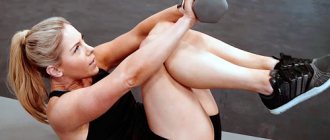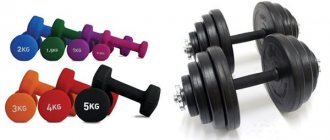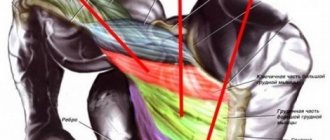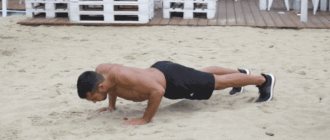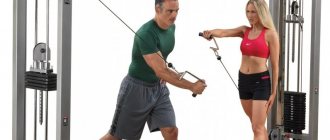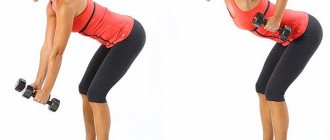Why did this happen?
Yes, very simple. Because the anatomy of our breasts has a very unusual structure.
As I said in the article about how to pump up your chest at home, the pectoral (pectoral) muscles are unique to some extent, because they are attached at different angles to the sternum and collarbone, FORMING THE LETTER “G”, which is why they need to be trained under different angles.
The UPPER PART occupies most of the pectoral muscles, so to a greater extent it determines the appearance of the WHOLE BREAST!
If we imagine in a very exaggerated way the ratio of the upper, middle and lower parts of the chest, then:
- TOP: 60%
- MIDDLE: 30%
- BOTTOM: 10%
Do you understand why I place the main emphasis on the upper part?
By the way, when working on an inclined bench (20-30 degrees), the middle part is also involved in the work! Those. you use almost the entire array of pectoral muscles.
The incline bench press is the so-called BODY PRESS, i.e. aimed specifically at muscle growth, and not at lifting maximum weight in all possible ways.
You most likely will not be able to squeeze out the same weight as on a horizontal bench, but in terms of muscle growth, this will be the BEST SOLUTION, because... uses almost the entire muscle mass of the chest.
How to pump up beautiful breasts without the help of a trainer
Of course, training alone is not enough; you must adhere to proper nutrition. It reduces the accumulation of subcutaneous fat and activates muscle growth. After all, a large amount of fat does not allow you to achieve a clear muscle architecture, hiding them under its layer.
It is very important that training is not one-time, but constant. They must be performed several times a week (2 - 3), and they should consist of various exercises aimed at swaying not only the lower part, but also the upper part of the chest
If you pump exclusively the lower part of your chest, a disproportion will arise in your body, and your breasts will not have an aesthetic appearance. Therefore, we advise you to include all the exercises described below in your training course.
Books and push-ups
Let's start the workout by working the middle part of the chest. For this you will need approximately 8 books with an average of 500 sheets each. The distance between two stacks of books (each with 4) should be approximately 60 centimeters. With our hands resting on the stacks, we begin to perform simple push-ups, trying to get as low as possible. As you lower, you should feel a stretch in every working muscle. Lowering should occur in 6 - 8 counts. The exercise is performed slowly, because we are working for results, not speed. Ideally, perform 4 sets of 15 push-ups.
Push-ups with a short pause
The next type of push-ups will have its own peculiarity. We put the books aside and begin to perform regular push-ups, only you need to perform 2 pauses of 2 - 3 seconds each:
- in the middle;
- at the end, going as low as possible.
- We perform, as in the previous exercise, 4 approaches, only 10 push-ups.
Push-ups with cotton
This exercise is not easy and requires skill. You will need to lower yourself down, slowly of course, then returning to the starting position, push off the floor as hard as possible, so that your palms come off the surface. At first, you can do without clapping, but as you master the technique of performing this exercise, introduce it.
Only 2 approaches are performed. You set the number of times yourself, i.e. the maximum possible.
Upper pectoral muscles
The part of the sternum that is most difficult to reach for pumping. It is possible to pump it up, but it is quite difficult. There is one exercise for this, but it is the most effective.
The point of this exercise is the same push-ups, but only the legs should be positioned higher than the body. For the effect to appear soon, it is recommended to increase the load and make the push-ups more difficult.
- delayed push-ups. At the lowest point, hold for 2 - 3 counts, then return to the original position;
- clap push-ups.
Perform 4 sets using excellent technique each time. The number of repetitions varies from 15 to 20.
Lower sternum muscles
Finally, we got to the most interesting part - how to pump up the lower pectoral muscles. The bars will be ideal helpers. To do this, you will need to allocate half an hour of your time 2–3 times a week and exercise in the fresh air.
How to pump up your lower chest on the uneven bars? Every man remembers these push-ups from school. But now they should be made a little more complicated, namely, stop at 2 - 3 counts at the bottom point. You should perform 15–20 repetitions in each of 4 approaches.
If you cannot perform the specified number of repetitions, then you should not push yourself into limits. It is better to do it fewer times, but with high quality. Don’t take a long break between sets; 40–60 seconds is plenty. Be sure to monitor the speed of execution; you should feel how each of your muscles works.
How to pump up your upper pectoral muscles
It is obvious. We need to shift the angle of load on the pectoral muscles! In other words, the INCLINE BAR/DUMBELL PRESS should be your main exercise that you start at the beginning of your workout.
We need to train the part that grows more difficult! The upper chest is almost not involved in other exercises, so it almost always receives less load if it is not trained specifically.
What bench angle should I choose?
The question is very important, because... here you need to hit the target, namely, the top of the chest.
- The higher the angle of inclination, the more deltas are involved in the work.
- The lower the inclination angle, the more load goes into the triceps.
This point must be taken into account when choosing the inclination of the bench.
The ideal option, in my opinion, would be an angle of 20-30 degrees. 45 degrees is already too much! The deltoids are strongly involved in the work and take the load off the pectoral muscles. We don't need this.
We adjust the bench to 20-30 degrees and forward.
Hand position
The width of the grip should be such that at the lowest point of the amplitude of movement of the barbell, the forearms become PARALLEL to each other. If you are working in partial amplitude, then the grip should be slightly wider than usual.
Leg position
A bodybuilder's legs should be higher than a powerlifter's. You can put them on a stand or move the bench to the row of dumbbells and put them there. This way, you remove the “bridge” (you don’t arch your back), thereby isolating the pectoral muscles even more.
Plus, in this position, you do not help yourself with your legs, without involving other muscles in the work.
Number of exercises, approaches and repetitions
This is the so-called TRAINING VOLUME!
For a beginner, I would do 2-3 exercises, 3-4 sets, 6-12 reps. This is after 2-3 months of training, when you have already learned to FEEL YOUR CHESTS when working with light weights.
The best exercises for the upper pectoral muscles
The development of training for pumping the upper chest zone should take into account the athlete’s capabilities:
- If there are time constraints or there is no possibility of using special equipment, then the loads can be carried out at home.
- Workouts in the gym.
The second option is preferable, since in this case the effect will be achieved faster. Exercises for home and for a specialized room will differ significantly.
Upper pectoral muscle training at home
It is quite difficult to pump up the upper chest area at home, but even this option is not excluded. The following exercises are suitable for this purpose:
- Push ups. We are not talking about a classic version of the exercise, which is suitable for working out the chest in general, but about a slightly more complicated version of it. It is necessary that the legs are higher than the torso; the greater the height difference, the greater the load on the desired area. In this case, the arms are placed wide apart and placed as high above the head as possible.
- Raising arms while lying down. The exercise is quite specific; it will require a slippery surface or movable supports, for example, pre-designed boards on wheels, or you can purchase ready-made wheels for push-ups. On slippery floors, scraps of fabric such as silk or chiffon can serve as movable support. To perform the exercise, you need to take a lying position with support points on your knees and hands. In this case, the palms are placed on scraps of fabric or prepared planks. The arms are spread to the sides and returned to the starting position. The effectiveness of such a load for the upper part of the muscles is enormous, but implementation is possible only for people with good physical fitness; a beginner is unlikely to master this exercise.
- Upside down push-ups. This exercise also requires serious physical preparation. You need to stand on your hands, while you can rest your heels on the wall. From the starting position, you need to bring your head as close as possible to the floor, bending your elbows, and return back.
The listed exercises can be included in morning exercises, but do them not daily, but twice a week.
How to pump up your upper chest
Like any muscle, this part of the chest grows if three conditions are met:
- PROGRESSION OF LOAD (the volume of training should increase). Perhaps the main rule, because THERE IS NO SENSE FOR MUSCLES TO INCREASE IF THE LOAD DOES NOT INCREASE.
- THE LOAD MUST HIT EXACTLY ON THE TARGET (you need to learn to feel the muscles you want to develop).
- NECESSARY RECOVERY (small meals 6-12 times a day + sleep 8-10 hours).
That's all. The more scrupulously you follow these rules, the faster you can pump up your upper pectoral muscles. It's not as difficult as it seems.
Give your muscles a rest
If you feel very tired, it makes sense to interrupt your training program . During the break, you need to give yourself enough time to sleep and eat well. Thus, your muscles will receive an additional portion of energy, which will be aimed at increasing muscle mass. After such a break, as a rule, there is an increase in strength and physical activity. Give your muscles a good rest. But after rest, you can use this technique: start working on the lagging part of the chest, and the results will not keep you waiting long.
To achieve good results, remember the main rule of bodybuilding - never repeat the same training regimen for too long in the hope that it will ever give results. Supplement your workouts with new exercises, do drop sets and negative repetitions, change the angle of the bench - all this will not allow the body to adapt to the same type of load and will give impetus to the explosive growth of the muscles of the upper chest.
upper chest pectoral pectoral
Upper Chest Workout Program
If I were a complete beginner, I would start by installing competent equipment. I would work for 2-3 months with light weights to understand how the pectoral muscles contract, how they work, how to properly isolate this muscle group from others.
Training program for a green beginner
I wouldn't do more than 2 basic exercises. I would use light weights and pay special attention to muscle feeling.
Take your time. Know how to wait and endure. Read a good article about this here.
- Incline barbell press : 2-3 sets x 12-15 reps.
- Incline dumbbell press: 2-3 sets x 12-15 reps.
Note: USE 50% of your working weight! If you press 50 kg for 6-8 reps, then take 25 and learn to competently contract your pecs and feel their contraction.
Training program for a beginner
If you have already trained for 2-3 months and can already “pull” your pecs in a calm state, as well as press dumbbells and barbells with your eyes closed, focusing only on your sensations, then you can move on to hypertrophy training.
- Incline bench press : 4-5 sets x 6-12 reps.
- Incline dumbbell press : 4-5 sets x 6-12 reps.
- Dumbbell flyes lying on an incline bench : 3-4 sets x 8-12 repetitions.
Why does the inner part of the breast lag behind?
To pump up your upper chest, you need to learn 6 exercises:
- Bench press at different angles.
- Dumbbell raises at 30 and 45 degree angles.
- Press dumbbells at the same angles.
- Bringing your arms together in a crossover (arms above parallel).
- Dips. This exercise is more focused on working the lower chest and outer part, but don't let that fool you. We will do it, as it is very effective for complex muscle development.
- Push-ups from the floor upside down.
The human muscular frame is determined genetically. We have all probably noticed that some people have well-developed legs, while others, for example, have well-developed backs. The same goes for the pectoral muscles. For some, the chest muscles are naturally dense and evenly developed, while for others they are far behind.
Genetics is the main cause of weak breasts.
A secondary reason is poor training. For example, an athlete constantly does only dips and nothing else. This exercise develops the lower part of the chest (“edges”) well. As a result, such an “athlete” will receive good triceps, and in addition unevenly developed pectoral muscles with a lagging center.
Let's look at the basic principles that allow you to pump up the middle of the pectoral muscles:
- Many chest exercises work the shoulder girdle and arm joints. Therefore, without a good warm-up and preparation, you cannot approach working weights.
- The basis of the training should be basic exercises performed in 3-4 sets of 8-12 times. Do insulating elements for 3-4 sets of 12-15 times.
- Increase the weight load periodically. Working with static weights will not bring results, as the chest muscles will quickly get used to and adapt.
- Add a classic bench press to your workout. This exercise helps to increase the overall volume of the pectoral muscles, using both the outer and inner sections of the chest.
- If you want to pump up your inner chest, one workout will not be enough. We recommend training 2 times a week, for example, on Monday and Friday.
Goal No. 6 - pre-fatigue of the pectoral muscles
If your triceps are sore after a hard chest workout, they're likely putting more strain on them than your pecs. You can minimize triceps involvement by using pre-exhaustion training. With this program, you perform isolation exercises for the pectoral muscles, in which the triceps are practically not active, such as dumbbell flyes or crossovers. After your pectoral muscles are tired from isolation exercises, you move on to multi-joint compound exercises. At the same time, the triceps are still fresh and will not fail before the pectoral muscles. This training program is specifically designed to overcome stagnant growth of the pectoral muscles (plateau) . It should be mentioned that in isolation exercises the number of repetitions should be higher, but with less weight, so as not to overload the joints.
Preparation
Choose a weight that allows you to reach muscle failure for the number of sets listed below. Due to the unusual design of the program, you will feel stronger on dumbbell flyes, but slightly weaker on the press, so you need to adjust the weight of the apparatus accordingly.
Training with pre-exhaustion of the pectoral muscles
- Incline dumbbell flyes. 3x10, rest one minute - ninety seconds.
- Butterfly trainer. 4x8-8-12-12, rest one minute - ninety seconds.
- Bench press.
3x(8-10), rest one minute - ninety seconds.
- Incline dumbbell press. 3x10, rest one minute - ninety seconds.
- Smith machine incline bench press. 3x (10-12), rest one minute - ninety seconds.
How to pump up your chest muscles. 6 effective programs
Pumping the inner part of the pectoral muscles should be regular and structured. Otherwise, there will be no positive effect from the classes. We recommend studying according to a clearly drawn up plan. An example of such a plan is presented below.
At the end of your workout, perform a simple chest stretch to help your muscles recover faster. Train twice a week, leaving 2-3 days of rest between sessions. The presented program is designed for 8-10 weeks. After this it needs to be changed.
Skip to content
We have to disappoint you right away, there is no universal training program to pump up your chest muscles. Below are six proven workouts that will help you increase your chest size, no matter your experience.
As they say, all roads lead to Rome. Only some get there much faster. Ultimately, most workouts sooner or later lead to results, but there is a more effective way: perform exercises that are maximally focused on results.
All of the following training programs have different goals. Choose the one you need and use it for 4-8 weeks, on the day you pump your breasts.
After this, you can return to your regular workouts or choose one of the following programs below.
Note. These workouts do not include a warm-up, but never forget about it. Just don't overdo it and don't warm up to muscle failure.
In most of the exercises below, the main criterion for selecting weight is muscle failure - when you are unable to complete the exercise without a clear violation of technique or the help of a spotter.
This is an indicator that you have given maximum load to the muscles. And as a result, muscle fibers received a powerful stimulus for growth.
For obvious reasons, in situations where no one is insuring you, you cannot go completely to failure - this can lead to serious injuries.
Based on three principles:
- Start your workout with multi-joint basic exercises.
- Work the muscles from different angles.
- High total volume of training (number of exercises, approaches, repetitions).
We invite you to familiarize yourself with the Best Exercises for Male Strength
The workout below is built on the principle of a reverse pyramid, which allows you to achieve muscle failure in a greater number of approaches. Plus, it starts with a dumbbell bench press, not a barbell press.
Because dumbbells are more difficult to control. This is useful in this case - it allows you to use a wider range of motion.
Many people have noted that replacing barbells with dumbbells leads to an increase in muscle mass.
Preparation
- Choose a weight that allows you to reach muscle failure for the number of sets listed below.
- Reduce the weight of the apparatus for more repetitions in subsequent sets. If you have a spotter, do the heaviest sets first.
- If no one is insuring you, train as close to muscle failure as possible.
Complete each last approach to each exercise with a drop set (after completing the last approach, take the apparatus approximately 25% lighter and, as it were, continue to perform the last approach until complete failure, and the pause should be minimal, preferably no more than 10-15 seconds). It is very effective for gaining muscle mass.
- Dumbbell bench press lying on a horizontal bench. 4 sets: 1st (6-8 reps), 2nd (6-8), 3rd (8-10), 4th (10-12) reps. We rest for one minute - ninety seconds.
- Incline barbell press. 3x (6-8), (8-10), (10-12), rest one minute - ninety seconds.
- Seated chest press. 3x(8-10), (8-10), (10-12), rest for one minute - ninety seconds.
- Raises with dumbbells on an incline bench. 3x10-10-12, rest one minute – ninety seconds.
- Reduction of arms in the butterfly simulator. 3x12-12-12 (several partial sets after reaching muscle failure on the last set), rest one minute to ninety seconds.
Simply hammering light weights with high reps is no longer considered the best way to get dry.
Instead, the focus is on increasing calorie burn and post-workout oxygen consumption, which is the number of calories you burn after your workout is completed.
This program combines multi-joint exercises, supersets, high-repetition sets with short rest periods to burn unnecessary fat.
Preparation
Choose a weight that allows you to reach muscle failure for the number of sets listed below.
The first exercise is performed with relatively heavy weights, which is key to preserving muscle tissue and maintaining a high metabolism while you diet.
Aim to rest between sets as short as possible at a high heart rate (up to 110-120 beats per minute). What makes this program both a strength and cardio workout.
Superset
- Bench press lying on a horizontal bench.
3x8, no rest.
- Raising arms with dumbbells on a horizontal bench. 3x(10-12). Rest as needed.
Superset
- Incline bench press on a Smith machine.
3x10, no rest.
- Raises with dumbbells on an incline bench. 3×10-12. Rest as needed.
Superset
- Seated chest press. 3 sets of 10 reps, no rest.
- Push-ups: 3 x to failure. Rest as needed.
For beginners, the most important thing is to learn how to perform the exercises correctly and improve the technique until it becomes automatic. Lifting heavy weights is not that important, especially at first.
This workout is heavily machine based, allowing you to become familiar with strength training under more control (more safety).
Once you get the hang of the exercises, move on to free weights, which may seem quite challenging for your coordination, but is a more effective method of gaining muscle mass.
Preparation
Choose a weight at which you almost reach muscle failure. The first two exercises are performed using the pyramid principle: increase the weight after the first set and perform fewer repetitions.
- Bench press in the simulator. 3x15-12-10, rest one minute - ninety seconds.
- Seated chest press. 3x15-12-10, rest one minute - ninety seconds.
- Reduction of arms in the butterfly simulator. 3x15-12-10, rest one minute - ninety seconds.
- Push-ups. 2 x until muscle failure, rest one minute - ninety seconds.
This workout uses incline presses twice. However, the method is changing. For example, the incline of a barbell bench is much steeper than when using dumbbells. Therefore, the upper pectoral muscles will be worked differently.
Secondly, you will be working at different intensities and ranges of approaches from each angle. We don't give up other angles: this program includes the head down press.
After finishing the multi-joint exercises, you move on to single-joint exercises, which focus on the upper part of the pectoral muscles.
Preparation
This program follows the reverse pyramid principle, which means you decrease the weight slightly on the third and fourth sets. If possible, you need to use a different inclination of the bench when bringing your arms together in a crossover. Just not too cool.
If you have a spotter, do the heaviest approaches first; if there is no assistant, try to do them as close to muscle failure as possible.
- Incline barbell press. 4x(6-8), (6-8), (8-10), (8-10), rest one minute - ninety seconds.
- Smith machine incline bench press. 3x(8-10), rest one minute - ninety seconds.
- Incline dumbbell press (low angle, approximately 30°). 4x(8-10), (8-10), (10-12), (10-12), rest one minute - ninety seconds.
Superset
- Reduction of arms in a crossover on an inclined bench. 3x(10-12), without rest.
- Push-ups with your feet elevated, rest for one minute to ninety seconds.
The principle is similar to the upper chest workout, but inverted. You do more exercises that target the lower chest area at different angles. In this case, the load will also fall on the upper part. The training ends with a powerful pumping superset: dips and crossovers. To get a good feel for the bottom of the pecs.
Preparation
This workout follows the reverse pyramid principle, which means you decrease the weight slightly on the third and fourth sets. To accentuate your chest during dips, lean forward with your legs bent back and keep your elbows wide during the dips.
- Bent-down barbell bench press. 4x(6-8), (6-8), (8-10), (8-10), rest one minute - ninety seconds.
- Incline dumbbell press. 3x(8-10), rest one minute - ninety seconds.
- Seated chest press. 4x(8-10), (8-10), (10-12), (10-12), rest one minute - ninety seconds.
Superset
3 x until muscle failure, without rest.
- Crossover. 3x (10-12), rest one minute - ninety seconds.
If your triceps are sore after a hard chest workout, they're likely putting more strain on them than your pecs. You can minimize triceps involvement by using pre-exhaustion training.
With this program, you perform isolation exercises for the pectoral muscles, in which the triceps are practically not active, such as dumbbell flyes or crossovers.
After your pectoral muscles are tired from isolation exercises, you move on to multi-joint compound exercises. At the same time, the triceps are still fresh and will not fail before the pectoral muscles.
This training program is specifically designed to overcome stagnant growth of the pectoral muscles (plateau). It should be mentioned that in isolation exercises the number of repetitions should be higher, but with less weight, so as not to overload the joints.
Preparation
Due to the unusual design of the program, you will feel stronger on dumbbell flyes, but slightly weaker on the press, so you need to adjust the weight of the apparatus accordingly.
- Incline dumbbell flyes. 3x10, rest one minute - ninety seconds.
- Butterfly trainer. 4x8-8-12-12, rest one minute - ninety seconds.
We invite you to familiarize yourself with Powerful potency at home
3x(8-10), rest one minute - ninety seconds.
- Incline dumbbell press. 3x10, rest one minute - ninety seconds.
- Smith machine incline bench press. 3x (10-12), rest one minute - ninety seconds.
Goal No. 2 - breast contouring (relief)
Simply hammering light weights with high reps is no longer considered the best way to get dry. Instead, the focus is on increasing calorie burn and post-workout oxygen consumption, which is the number of calories you burn after your workout is completed. This program combines multi-joint exercises, supersets, high-repetition sets with short rest periods to burn unnecessary fat.
Preparation
Choose a weight that allows you to reach muscle failure for the number of sets listed below. The first exercise is performed with relatively heavy weights, which is key to preserving muscle tissue and maintaining a high metabolism while you diet. Aim to rest between sets as short as possible at a high heart rate (up to 110-120 beats per minute). What makes this program both a strength and cardio workout.
Terrain training
Superset
- Bench press on a horizontal bench.
3x8, no rest.
- Raising arms with dumbbells on a horizontal bench. 3x(10-12). Rest as needed.
Superset
- Incline bench press on a Smith machine.
3x10, no rest.
- Raises with dumbbells on an incline bench. 3×10-12. Rest as needed.
Superset
- Seated chest press. 3 sets of 10 reps, no rest.
- Push-ups: 3 x to failure. Rest as needed.


